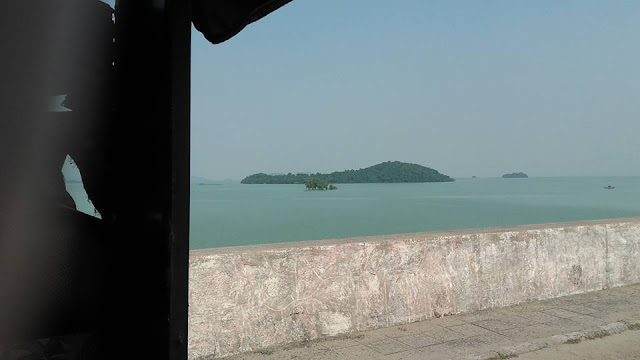Birkul was a coastal village in Bengal surrounded by dense forest. The British were fond of this hamlet where trees outnumbered human beings & sea talked louder. Governor General Warren Hastings was so much in love with Birkul that he called it 'Brighton of the East'.
Birkul, or Hastings' Brighton underwent sea change keeping pace with time.It's renamed Digha. The forest-clad hamlet metamorphosed into a happening sea town of Bengal & became part of our life. It's picnic spot, family tour destination,honeymoon spot,location for film shoots, site for educational tours, fish trade centre , what not!
Digha has come a long way from Birkul & the journey continues. The Government works nonstop for the development ensuring frequent makeovers of Digha. A huge gate in the beautiful combination of blue & white welcomes you to Digha. This is the latest addition to the illustrious CV of the beach town. The gate is shaped like a sailboat.
 |
| DIGHA GATE |
A new beach named Udaypur has been developed nearby. The beach is ideal for those who love to stay far from madding crowd. It's connected with Digha by marine drive road,the first of its kind in West Bengal. Work is on to extend the road up to Tajpur in the east.A walk down the road in the setting sun is therapeutic.
 |
| MARINE DRIVE ROAD |
 |
| UDAYPUR |
In near future Digha is going to be connected with Gopalpur in southern part of Odisha by a seaside road ensuring us a memorable journey.
What is most amazing about Digha is its dynamism. It didn't waste time basking in the glory of cashew nut farming or a marine aquarium. It keeps changing itself & appears in new avatars. It is now going to the extent of introducing ropeway service from Digha to Shankarpur.
The beach in Old Digha has been reduced to nothing by severe erosion. So people use the beach in New Digha. This is an amazing beach that can cater to everyone,from fish lovers to adventure lovers, from shopaholics to lovebirds. Fried prawns,cashews,gigantic coconuts,speed boats, handicrafts of seashells,cosy corners, everything is served on the beach.
Unlike its Old counterpart, New Digha is safe for bathing. Since Bengalis have a penchant for sun-bathing, they stream in to New Digha beach & merge with the Bay of Bengal. They bathe,sip coconut water,click groupies & again get back to bathing.
Digha is a 'super power' in tourism industry of Bengal. Except Darjeeling there's nobody else in West Bengal who is richer,more famous & influential than Digha. It's chock-a-bloc round the year.People rush to Digha whenever they feel like,even at the time of calamity like cyclone!
 |
| FULL-MOON |
Digha caused a sea change in the socioeconomic life of the coastal belt of East Midnapore district. It upgraded a number of adjoining coastal villages to seaside resorts of repute. Communication has improved remarkably. All the roads are in good shape. The area is connected to Kolkata & other parts of Bengal by Digha-Howrah railroad.
Fish trade in the area has gained momentum. Shankarpur's claim to fame is now the wholesale fish market, not the tranquil beaches anymore .
Banks, ATMs,hospitals,nursing homes,hotels,mobile towers,cars of various shapes & sizes changed the area completely.
Digha supports Odisha as well. Places like Talsari,Chandaneswar,Bichitrapur in the neighbouring state have become popular tourist spots thanks to their proximity to Digha . Most of the tourists who floack to these places are neither from Bhubaneswar nor Cuttack,but Digha.
































